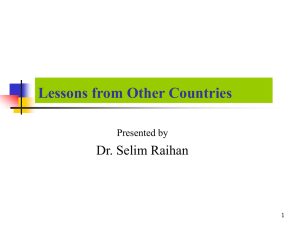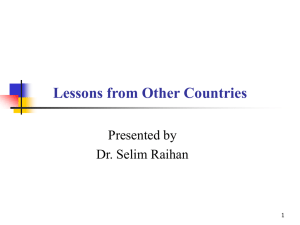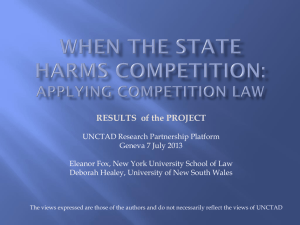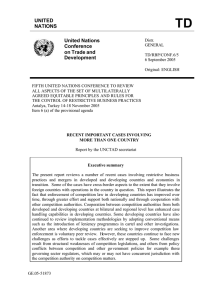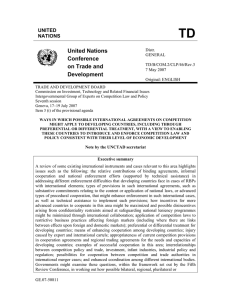Competition Policy and Law: Lessons from Other Countries
advertisement
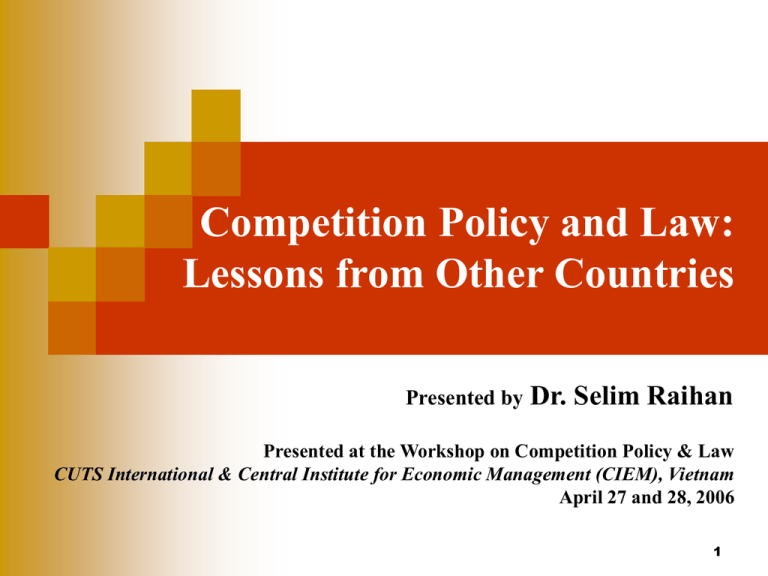
Competition Policy and Law: Lessons from Other Countries Presented by Dr. Selim Raihan Presented at the Workshop on Competition Policy & Law CUTS International & Central Institute for Economic Management (CIEM), Vietnam April 27 and 28, 2006 1 In this session we will discuss….. Competition policy in different countries. Some case studies: What are the evidences of competition policy helping consumers in other countries? Lessons that Vietnam can derive from cross country experiences 2 Competition Policy in Different Countries 3 Australia Malaysia India South Africa Chile Venezuela Bangladesh 4 Competition Policy in Australia Australian competition policy dates from 1906 when the first Federal law dealing with restrictive practices was enacted. Contemporary Australian competition policy stems from the 1965 Trade Practices Act. Liberalisation of the economy in the mid 1970s and the 1980s (tariff cuts of 1973, floating of the dollar, and the elimination of foreign exchange controls). The Competition Policy Reform Act was enacted in 1995. 5 The NCP's Institutional Framework The Australian Competition and Consumer Commission (ACCC): An independent statutory authority The National Competition Council: An independent advisory body The Australian Competition Tribunal: A quasi-judicial review body 6 For details please see….. Global Competition Forum Website: www.globalcompetitionforum.org Parliament of Australia: Parliament Library: http://www.aph.gov.au/library/intguide/econ/ncp_ebrief.htm 7 Competition Policy in Malaysia No national competition policy and law. Sectoral approach to competition and regulation. Policies of deregulation and liberalisation of the economy since the 1980s There are about 30 laws to regulate certain activities of enterprises and to protect consumer interests. Under these laws a consumer or trader may seek redress through the appropriate Ministry, public agency or via the Civil Courts. No administrative authority for determining appropriate business ethics and trade practices. 8 For details please see…… Global Competition Forum Website: www.globalcompetitionforum.org Lee, Cassey (2004) : Competition Policy in Malaysia, CRC Working Paper 68. 9 Competition Policy in India India had a competition law since 1969 by the name of Monopolies and Restrictive Trade Practices Act. That law became redundant for several reasons. Therefore a new law has been drafted. India has consumer protection act and corporation working for securing consumer rights against any anticompetitive practices of firms. The Consumer Protection Act is known as COPRA (1986). It recognizes the rights such as safety, information, choice, representation, redress, and consumer education to the consumers. 10 For details please see…… Global Competition Forum Website: www.globalcompetitionforum.org CUTS Centre For Consumer Action Research And Training (CART): “Consumer Rights And Its Expansion Rights And Responsibilities” 11 Competition Policy in Bangladesh No formal competition policy and law. No formal competition authority. Different governmental policies: Trade policy, Industrial policy, Exchange rate policy, FDI policy, Privatisation policy, Labour Policy, etc. The Monopolies and Restrictive Trade Practices (Control and Prevention) Ordinance Promulgated in 1970 is still in force in Bangladesh, which provides for taking action against any unfair competition or concentration of economic power, or illegal trade practices. 12 For details please see…… Global Competition Forum Website: www.globalcompetitionforum.org BEI (2005), “Competition Scenario in Bangladesh”, Prepared for CUTS-International Within the framework of the 7Up2 Project “Advocacy and Capacity Building on Competition Policy and Law in Asia” 13 Competition policy in South Africa The Competition Commission plays a pivotal role in creating environment for efficient business sector and in ensuring competitive prices and greater product choice for consumers. The Competition Act (Act. No.89 of 1998) was passed by Parliament in September 1998. The enforcement agencies are the Competition Commission, the Competition Tribunal and the Competition Appeal Court. 14 For details please see…… Global Competition Forum Website: www.globalcompetitionforum.org Comparative Study of Sectoral Regulation in Developing Countries: Lessons for policy, Governance and Implementation -A Case Study of South Africa. 15 Competition policy in Latin American Countries The Chilean system of protection of Competition in markets is integrated by The Tribunal for the Defence of Free Competition and The Economic National Prosecutor's Office. The Decree-Law 211 of 1973 is the legal framework of this system. The free competition regime in Venezuela started in 1992 when the government settled a group of new policies in order to prepare the country to face globalisation process, including to the Law to Promote and Protect the Exercise of Free Competition. 16 Case Studies 17 The Indian Case Study A gas supplier in India was forcing the buyers to buy hot plates with fresh gas connection. The Competition Authority held such a practice. The Authority directed that the gas agency should make it clear on the invoice that the hot plates were purchased voluntarily. Further a notice board should be prominently displayed in the agency’s premises that the customers were free to purchase hot plate either from Ghoten Gas agency or from any other source. Source: CUTS “Competition Policy and Law Made Easy” 18 The Malaysian Case Study Prior to 2002, MAS was a monopoly operator in the domestic airline market. With the entry of AirAsia the domestic airline market became more competitive. AirAsia offers no-frills domestic flights at low fares. MAS responded by offering 50 percent discounts for ten seats in every flight. AirAsia also responded to MAS’s pricing strategy by offering lower fares. Despite MAS’s plea for government intervention to resolve the perceived ‘price war’, the government has maintained that the competition between the two firms as healthy competition. 19 The Spanish Case Study Four Sugar producers in Spain were engaged in market allocation agreement that restricted sugar supply to the level at which maximum monopoly profits could be earned. As a result. Spanish sugar prices, for many years, were 5 to 9 percent higher than those in the rest of Europe. The Spanish Service for the Defence of Competition uncovered the cartel and slapped 8.7 million euros fine on the four producers. Source: Report of the Ministerial level meeting of the OECD, 2000 20 The Kenyan Case Study South Africa Bottling Company Pty (SABCO) proposed of taking over all the other bottling companies and consolidating them into one entity. The Kenyan competition authority decided that such a plan would lead to both horizontal and vertical concentration of market power and the likely abuse of dominance, and accordingly stopped the process from going further. Thus, the Kenyan authority, dealing with a huge global company, applied the competition law to foreclose likely anticompetitive practices in the market. See pages 14,15 of UNCTAD, April 2002: Recent Important Competition Cases in Developing Countries 21 The Argentinean Case Study Four foreign companies active in Argentina as suppliers of medical oxygen to public and private hospitals were fined 70.3 million pesos (US$ 24 million) for operating a price cartel for medical oxygen. See page 4 of UNCTAD, September,2005 : Recent Important Cases Involving More Than One Country 22 The Brazilian Case Study Three chemical or pharmaceutical firms (Roche, BASF and Aventis Animal Nutrition, the latter formed through the merger of Rhône-Poulenc and Hoescht) fixed the prices and allocated market shares of bulk vitamins in Brazil as an extension of their participation in an international vitamins cartel which was prosecuted in the United States. See pages 5,6 of UNCTAD, April 2002: Recent Important Competition Cases in Developing Countries 23 Lessons for Vietnam…… 24 Components of competition policy Competition Policy Government Policies Competition Law Private Actions Deregulation and Privatization Trade Policy Industrial Policy Consumer Policy Regulations Governing Capital and FDI Other Policies 25 Competition Law (National) Anti-Competitive Agreements Between Firms ( Collusion) e.g. Abuse of a Dominant Market Position e.g. •Import cartels •Price fixing •Market sharing •Bid rigging •Limiting production or investment •Refusal to buy or supply •Tie-in arrangements •Exclusive-dealing arrangement •Resale price maintenance •Territorial allocation between supplier and dealer •Predatory pricing •Price discrimination •Excessive pricing •Exclusionary vertical restrictions •Abuse of intellectual property monopoly Regulation of Mergers to Prevent Tactics to Gain Excessive Dominance in a Market Applies to: •Total unification of the companies involved •Buying of sufficient shares in a company so as to have a say in policy formulation 26 Need for a Competition Policy Benefits of to Consumers: Ensures a fair deal in the market place with The best possible choice of quality, The lowest possible prices, and Adequate supplies of commodities. 27 Benefits for efficient producers A safeguard against practices that could drive companies out of business. Lower entry barriers in the market promote entrepreneurship and growth of small and medium enterprises. Efficient allocation and utilization of resources ensures more output and employment (although in the short run there can be some job losses, which should be covered by some safety-net programs). Control of international competition, such as international cartels, that may adversely affect a country’s trade and development. On the whole, a competition policy maintains and promotes the competitive spirit and culture in the market. 28 Globalization and the need for Competition Policy Globalization and Competition Outcome of threat to Concentration of Market Power Therefore, we need competition policy to monitor, prevent and control anti-competitive practices. 29 Concluding Observations Competition policy and law and consumer protection policy can take different forms for different countries. There are verities of anti-competitive practices and consumer abuses, so the regulatory authority should be innovative in nature. For developing countries, resource constraint is one of the major problem in establishing competition authority. It is very important that the reports on anticompetitive practices be published in the media to raise the awareness of the consumers. 30 Thank you!! 31
